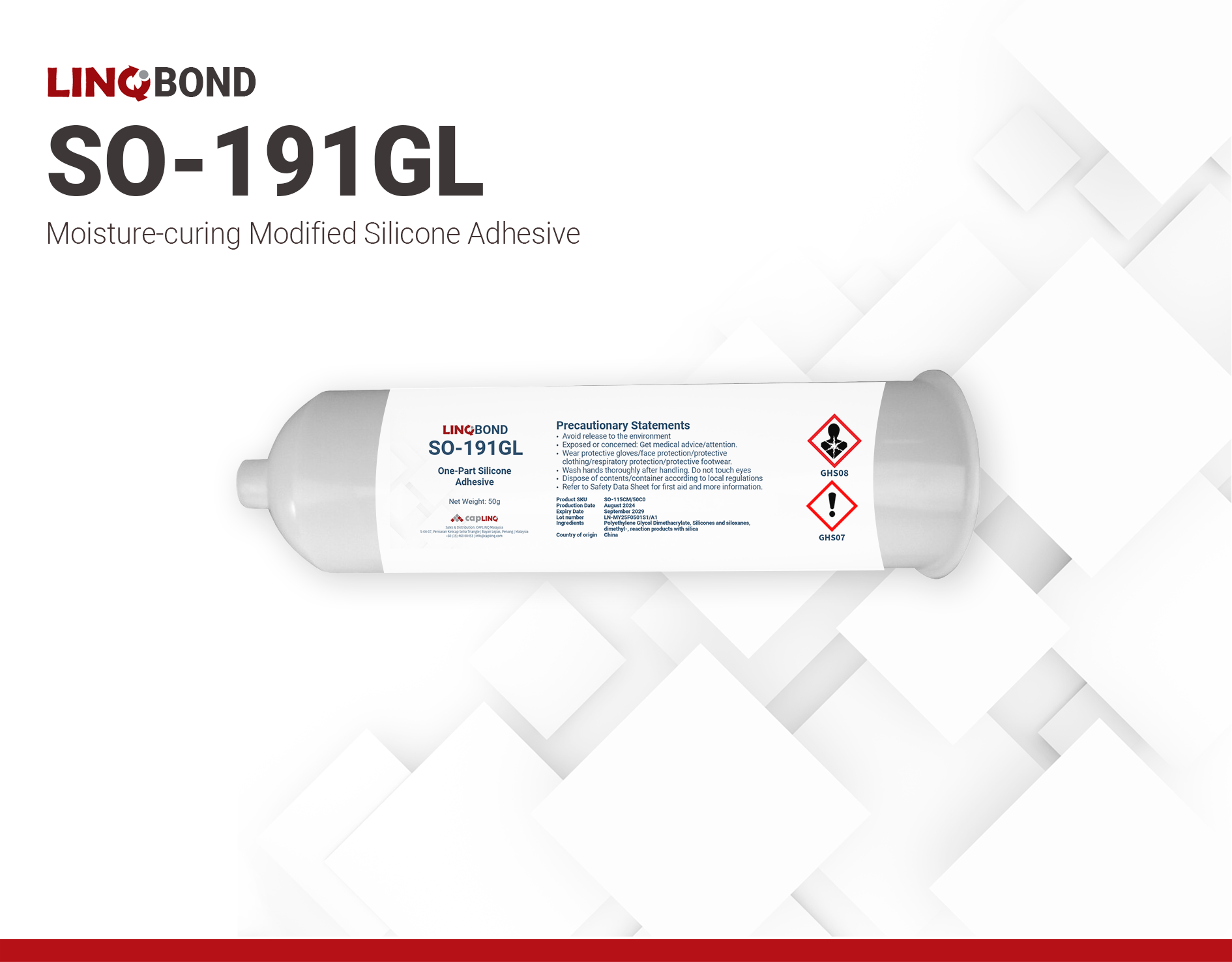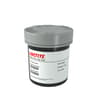LINQBOND SO-191GL | Moisture Curing Modified Silicone Adhesive
Harmonization Code : 3506.91.90.99 | Prepared glues and other prepared adhesives, not elsewhere specified or included; products suitable for use as glues or adhesives, put up for retail sale as glues or adhesives, not exceeding a net weight of 1 kg ; Adhesives based on polymers of headings 3901 to 3913 or on rubber; Other ; Other
Main features
- One-component
- Fast cure at low temperature
- High stability
Product Description
LINQBOND SO-191GL is a single-component, moisture-curing, modified silicone adhesive, engineered for robust substrate bonding across diverse materials including polymers, metals, and silica-based composites.
LINQBOND SO-191GL formulation contains alkoxy functional groups, leading to rapid curing upon exposure to ambient atmospheric moisture.
Product Key Features:
- Rapid Curing: Achieves cure state quickly through reaction with atmospheric moisture.
- Odorless Formulation: Designed for use in environments sensitive to volatile organic compounds (VOCs).
- Enhanced Adhesion Properties: Exhibits superior bond strength compared to conventional silicone adhesives.
- Diverse Substrate Compatibility: Establishes strong bonds with a variety of materials, including plastics, metals, and glass.
Applications
- Bonding components within electronic devices
- General industrial bonding and sealing of glass components
Technical Specifications
| General Properties | |||||||
| Appearance Appearance Appearance at room temperature. | Liquid | ||||||
| Color Color The color | Black | ||||||
| Specific Gravity Specific Gravity Specific gravity (SG) is the ratio of the density of a substance to the density of a reference substance; equivalently, it is the ratio of the mass of a substance to the mass of a reference substance for the same given volume. For liquids, the reference substance is almost always water (1), while for gases, it is air (1.18) at room temperature. Specific gravity is unitless. | 1.5 | ||||||
| Physical Properties | |||||||
| Thixotropic index Thixotropic index Thixotropic Index is a ratio of a material s viscosity at two different speeds in Ambient temperature, generally different by a factor of ten. A thixotropic material s viscosity will decrease as agitation or pressure is increased. It indicates the capability of a material to hold its shape. Mayonnaise is a great example of this. It holds its shape very well, but when a shear stress is applied, the material easily spreads. It helps in choosing a material in accordance to the application, dispense method and viscosity of a material. | 4 | ||||||
| Viscosity Viscosity Viscosity is a measurement of a fluid’s resistance to flow. Viscosity is commonly measured in centiPoise (cP). One cP is defined as the viscosity of water and all other viscosities are derived from this base. MPa is another common unit with a 1:1 conversion to cP. A product like honey would have a much higher viscosity -around 10,000 cPs- compared to water. As a result, honey would flow much slower out of a tipped glass than water would. The viscosity of a material can be decreased with an increase in temperature in order to better suit an application | 300,000 - 600,000 mPa.s | ||||||
| Chemical Properties | |||||||
| Water Absorption | 0.24 % | ||||||
| Mechanical Properties | |||||||
| |||||||
| Elongation Elongation Elongation is the process of lengthening something. It is a percentage that measures the initial, unstressed, length compared to the length of the material right before it breaks. It is commonly referred to as Ultimate Elongation or Tensile Elongation at break. | 608 % | ||||||
| |||||||
| Thermal Properties | |||||||
| |||||||
| Glass Transition Temperature (Tg) Glass Transition Temperature (Tg) The glass transition temperature for organic adhesives is a temperature region where the polymers change from glassy and brittle to soft and rubbery. Increasing the temperature further continues the softening process as the viscosity drops too. Temperatures between the glass transition temperature and below the decomposition point of the adhesive are the best region for bonding. The glass-transition temperature Tg of a material characterizes the range of temperatures over which this glass transition occurs. | -40 °C | ||||||
| Temperature Range | -40 - 200 °C | ||||||
| Thermal Conductivity Thermal Conductivity Thermal conductivity describes the ability of a material to conduct heat. It is required by power packages in order to dissipate heat and maintain stable electrical performance. Thermal conductivity units are [W/(m K)] in the SI system and [Btu/(hr ft °F)] in the Imperial system. | 0.25 W/m.K | ||||||
| Other Properties | |||||||
| RoHS Compliant RoHS Compliant RoHS is a product level compliance based on a European Union Directive which restricts the Use of certain Hazardous Substances in Electrical and Electronic Equipment (RoHS). Products compliant with this directive do not exceed the allowable amounts of the following restricted materials: lead, mercury, cadmium, hexavalent chromium, polybrominated biphenyls (PBB) and polybrominated diphenyl ethers (PBDE), with some limited exemptions | Yes | ||||||
Additional Information
Directions for Use
- Apply to a clean surface which should be free of dirt, grease or mold release. In many cases, a simple solvent wipe is sufficient.
- Pour or brush this product onto the substrates. It is not recommend to stir it onto the substrates to avoid formation of air bubbles. This product will be cured through air-drying but propeties depend on its thickness, curing temperatrue, and relative humidity.
- Use this product as soon as possible after opening the original package. When not in use, please replace the lid tightly and store in a cool and dry place.
- Cure time depends on part geometry, materials to be bonded, bondline thickness, and humidity. Cure schedule should be in accordance with actual specifications of production parts and equipment.
- Cured product is safe for contact with human skin.






